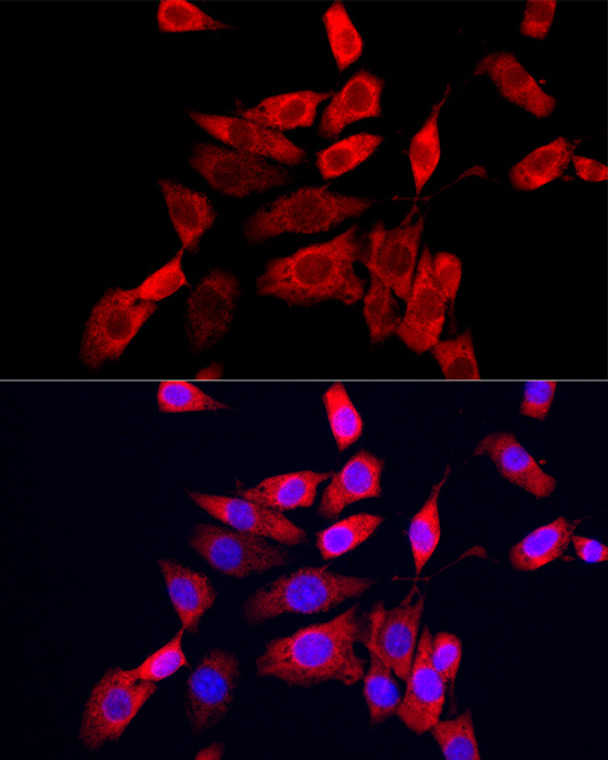| Host: |
Rabbit |
| Applications: |
WB/IF |
| Reactivity: |
Human/Mouse |
| Note: |
STRICTLY FOR FURTHER SCIENTIFIC RESEARCH USE ONLY (RUO). MUST NOT TO BE USED IN DIAGNOSTIC OR THERAPEUTIC APPLICATIONS. |
| Short Description: |
Rabbit polyclonal antibody anti-CXCL10 (22-98) is suitable for use in Western Blot and Immunofluorescence research applications. |
| Clonality: |
Polyclonal |
| Conjugation: |
Unconjugated |
| Isotype: |
IgG |
| Formulation: |
PBS with 0.05% Proclin300, 50% Glycerol, pH7.3. |
| Purification: |
Affinity purification |
| Dilution Range: |
WB 1:1000-1:5000IF/ICC 1:50-1:200 |
| Storage Instruction: |
Store at-20°C for up to 1 year from the date of receipt, and avoid repeat freeze-thaw cycles. |
| Gene Symbol: |
CXCL10 |
| Gene ID: |
3627 |
| Uniprot ID: |
CXL10_HUMAN |
| Immunogen Region: |
22-98 |
| Immunogen: |
Recombinant fusion protein containing a sequence corresponding to amino acids 22-98 of human CXCL10/IP-10 (NP_001556.2). |
| Immunogen Sequence: |
VPLSRTVRCTCISISNQPVN PRSLEKLEIIPASQFCPRVE IIATMKKKGEKRCLNPESKA IKNLLKAVSKERSKRSP |
| Tissue Specificity | Mainly secreted by monocytes, endothelial cells as well as fibroblasts. Expressed by epithelial cells in thymus. Microglial cells produce CXCL10 in response to viral stimulation. |
| Post Translational Modifications | Several proteases can mediate post-secretion cleavages. DPP4 cleaves CXCL10 on its N-terminal 2 amino acids leading to an antagonist form of CXCL10. This dominant negative form is capable of binding CXCR3 but does not induce signaling. MMP9 cleaves 9 amino acids instead. |
| Function | Pro-inflammatory cytokine that is involved in a wide variety of processes such as chemotaxis, differentiation, and activation of peripheral immune cells, regulation of cell growth, apoptosis and modulation of angiostatic effects. Plays thereby an important role during viral infections by stimulating the activation and migration of immune cells to the infected sites. Mechanistically, binding of CXCL10 to the CXCR3 receptor activates G protein-mediated signaling and results in downstream activation of phospholipase C-dependent pathway, an increase in intracellular calcium production and actin reorganization. In turn, recruitment of activated Th1 lymphocytes occurs at sites of inflammation. Activation of the CXCL10/CXCR3 axis also plays an important role in neurons in response to brain injury for activating microglia, the resident macrophage population of the central nervous system, and directing them to the lesion site. This recruitment is an essential element for neuronal reorganization. |
| Protein Name | C-X-C Motif Chemokine 1010 Kda Interferon Gamma-Induced ProteinGamma-Ip10Ip-10Small-Inducible Cytokine B10 Cleaved Into - Cxcl10(1-73 |
| Database Links | Reactome: R-HSA-380108Reactome: R-HSA-418594Reactome: R-HSA-6783783 |
| Cellular Localisation | Secreted |
| Alternative Antibody Names | Anti-C-X-C Motif Chemokine 10 antibodyAnti-10 Kda Interferon Gamma-Induced Protein antibodyAnti-Gamma-Ip10 antibodyAnti-Ip-10 antibodyAnti-Small-Inducible Cytokine B10 Cleaved Into - Cxcl10(1-73 antibodyAnti-CXCL10 antibodyAnti-INP10 antibodyAnti-SCYB10 antibody |
Information sourced from Uniprot.org
12 months for antibodies. 6 months for ELISA Kits. Please see website T&Cs for further guidance







